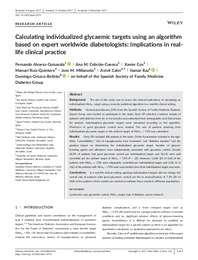Por favor, use este identificador para citar o enlazar este ítem:
https://hdl.handle.net/11000/31437
Calculating individualized glycaemic targets using an algorithm
based on expert worldwide diabetologists: Implications in real‐
life clinical practice
Título :
Calculating individualized glycaemic targets using an algorithm
based on expert worldwide diabetologists: Implications in real‐
life clinical practice |
Autor :
Alvarez‐Guisasola, Fernando
Cebrián‐Cuenca, Ana M.
Cos, Xavier
Ruiz‐Quintero, Manuel
Millaruelo, Jose M.
Cahn, Avivit
Raz, Itamar
Orozco‐Beltrán, Domingo |
Editor :
WILEY |
Departamento:
Departamentos de la UMH::Medicina Clínica |
Fecha de publicación:
2017 |
URI :
https://hdl.handle.net/11000/31437 |
Resumen :
Background: The aim of this study was to assess the clinical implications of calculating an
individualized HbA1c target using a recently published algorithm in a real‐life clinical setting.
Methods: General practitioners (GPs) from the Spanish Society of Family Medicine Diabetes
Expert Group were invited to participate in the study. Each GP selected a random sample of
patients with diabetes from his or her practice and submitted their demographic and clinical data
for analysis. Individualized glycaemic targets were calculated according to the algorithm.
Predictors of good glycaemic control were studied. The rate of patients attaining their
individualized glycaemic target or the uniform target of HbA1c < 7.0% was calculated.
Results: Forty GPs included 408 patients in the study. Of the 8 parameters included in the algorithm, “comorbidities,” “risk of hypoglycaemia from treatment,” and “diabetes duration” had the
greatest impact on determining the individualized glycaemic target. Number of glucose‐
lowering agents and adherence were independently associated with glycaemic control. Overall,
60.5% of patients had good glycaemic control per individualized target, and 56.1% were well
controlled per the uniform target of HbA1c < 7.0% (P = .20). However, 12.8% (23 of 246) of the
patients with HbA1c ≥ 7.0% were adequately controlled per individualized target, and 2.6% (6 of
162) of the patients with HbA1c < 7.0% were uncontrolled since their individualized target was lower.
Conclusions: In a real‐life clinical setting, applying individualized targets did not change the
overall rate of patients with good glycaemic control yet led to reclassification of 7.1% (29 of
408) of the patients. More studies are needed to validate these results in different populations
|
Palabras clave/Materias:
community care
glycaemic control
survey research
type 2 diabetes
HbA1c target |
Área de conocimiento :
CDU: Ciencias aplicadas: Medicina |
Tipo de documento :
info:eu-repo/semantics/article |
Derechos de acceso:
info:eu-repo/semantics/openAccess
Attribution-NonCommercial-NoDerivatives 4.0 Internacional |
DOI :
https://doi.org/10.1002/dmrr.2976 |
Aparece en las colecciones:
Artículos Medicina Clínica
|
 La licencia se describe como: Atribución-NonComercial-NoDerivada 4.0 Internacional.
La licencia se describe como: Atribución-NonComercial-NoDerivada 4.0 Internacional.
 La licencia se describe como: Atribución-NonComercial-NoDerivada 4.0 Internacional.
La licencia se describe como: Atribución-NonComercial-NoDerivada 4.0 Internacional.
.png)
